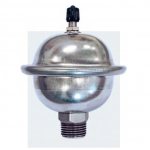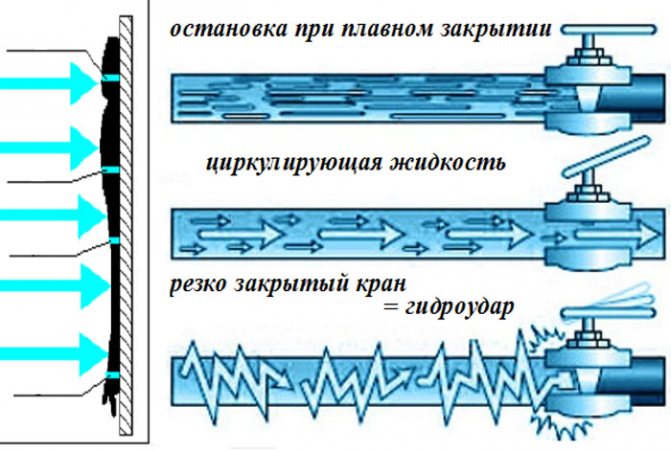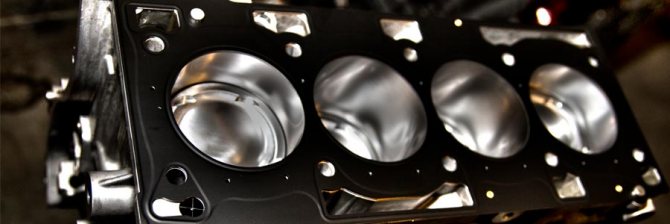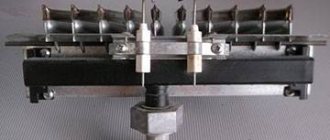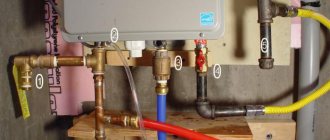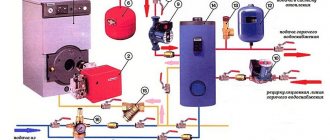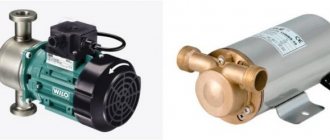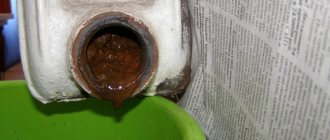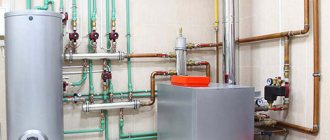Basic preventive measures
In addition to strict adherence to all established operating rules, it is possible to prevent the occurrence of an accident if a series of preventive actions are carried out in a timely and regular manner. The whole reason is that in the main heating or water supply system, absolutely all processes are closely interconnected. A water hammer, unforeseen by the user, is just the final destructive stage, which may well lead to various negative consequences. All this is happening against the background of the relatively poor technical condition of the pipes used for years.
The pressure drops and vibrations that arise only contribute to the formation of various cracks in the thickness of the metal. Over time, more serious defects appear, which, after the onset of a water hammer, instantly manifest themselves in areas of too high internal stress. These can be various bends, mechanical joints, and even welds.
Preventive manipulations include the following steps:
- Timely check of the pressure behind the flexible diaphragm of the exploited expansion vessel. If during this procedure the wizard discovers unsatisfactory results, then it is forbidden to operate the system without a qualitative adjustment.
- Checking the health of the involved security groups. This applies to an air vent, a safety valve, as well as a classic pressure gauge.
- Control of the valve position of the shut-off and control metal fittings.
- Periodically check the status of all filters. These elements are responsible for the retention of fine sand, classic scale, rust fragments. If necessary, the master needs to clean and then rinse the filters.
- Testing the system in use for leaks. You also need to check the degree of wear of all elements.
Many experts recommend replacing the classic rigid pipe with a plastic product. It is more flexible to use and expands quickly under pressure. But you need to be careful, since depressurization of the joints is not excluded.
A professional approach to prevention, which is aimed at maintaining the overall optimal condition of the heating and water heating system, necessarily includes elementary types of work. It is not recommended to ignore this stage. This is due to the fact that repairing heating in a private house entails a large waste of finance and free time. All the described protection measures will be effective if the approach to work is comprehensive. Only in such a situation is it possible to neutralize various undesirable consequences and extend the period of the coordinated work of the system.

Installing a high quality wash filter
System modernization and change
Many of the problems associated with water hammer are caused by deficiencies in the system itself. One of the reasons, for example, may be the joining of large pipes with pipes of a smaller diameter. The resulting resistance impedes the free passage of the liquid and contributes to an increase in pressure. You can eliminate this if you carry out a major overhaul of the heating system. In the course of its implementation, it is necessary to provide for a number of measures that significantly improve its ability to withstand a water hammer. Among them it is worth noting:
- shock-absorbing devices, which are pieces of elastic plastic, installed in front of the thermostat instead of a rigid pipe;
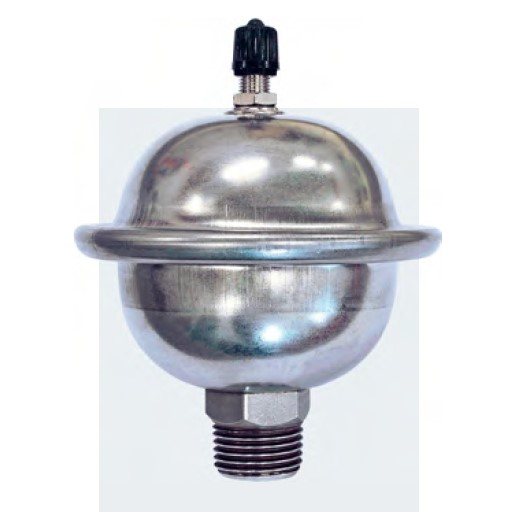

Water hammer damper Valtec CAR-19
- the introduction of a shunt with specially made holes, which allows to reduce the resulting pressure;
- use of special thermostats with water hammer protection.
These are just some of the measures to reduce the consequences and the possibility of water hammer. Having decided on them, an estimate for the repair of the heating system can be drawn up.
Fluctuations and their causes
Pressure surges indicate system malfunction. The calculation of pressure losses in the heating system is determined by summing the losses at individual intervals, which make up the entire cycle. Early identification of the cause and its elimination can prevent more serious problems that lead to costly repairs.
If the pressure in the heating system drops, this may be due to the following reasons:
- the appearance of a leak;
- failure of the expansion tank settings;
- failure of pumps;
- the appearance of microcracks in the boiler heat exchanger;
- power outage.
How to increase the pressure in the heating system?
Expansion tank regulates differential pressure
In the event of a leak, all connection points must be checked. If the cause is not visually identified, it is necessary to examine each area separately. For this, the valves of the taps are sequentially closed. The pressure gauges will show the change in pressure after cutting off a particular section. Having found a problematic connection, it must be tightened, previously additionally sealed. If necessary, the assembly or part of the pipe is replaced.
The expansion tank regulates the differences due to heating and cooling of the liquid. A sign of a tank malfunction or insufficient volume is an increase in pressure and a further drop.
Add a clearance of 1.25% to this result. The heated liquid, expanding, will force air out of the tank through the valve in the air compartment. After the water cools down, it will decrease in volume and the pressure in the system will be less than required. If the expansion tank is smaller than required, it must be replaced.
A rise in pressure can be caused by a damaged membrane or an incorrect setting of the heating system pressure regulator. If the diaphragm is damaged, the nipple must be replaced. It's quick and easy. To configure the reservoir, it must be disconnected from the system. Then pump the required amount of atmospheres into the air chamber with a pump and install it back.
It is possible to determine the malfunction of the pump by turning it off. If nothing happens after the shutdown, then the pump is not working. The reason may be a malfunction of its mechanisms or a lack of power. You need to make sure that it is connected to the network.
If there are problems with the heat exchanger, then it must be replaced. During operation, microcracks may appear in the metal structure. This cannot be eliminated, only replacement.
Why is the pressure in the heating system increasing?
The reasons for this phenomenon may be incorrect fluid circulation or its complete stop due to:
- the formation of an air lock;
- clogging of the pipeline or filters;
- operation of the heating pressure regulator;
- continuous feeding;
- shutoff valves overlapping.
How to eliminate drops?
An air lock in the system does not allow fluid to pass through. The air can only be vented. To do this, during installation, it is necessary to provide for the installation of a pressure regulator for the heating system - a spring air vent. It works in automatic mode. The new design radiators are equipped with similar elements. They are located at the top of the battery and operate in manual mode.
Why does the pressure in the heating system increase when dirt and scale accumulates in the filters and on the pipe walls? Because the flow of fluid is obstructed. The water filter can be cleaned by removing the filter element. It is more difficult to get rid of scale and blockages in pipes.In some cases, flushing with special means helps. Sometimes the problem can only be resolved by replacing the pipe section.
The heating pressure regulator, in the event of an increase in temperature, closes the valves through which the liquid enters the system. If this is unreasonable from a technical point of view, then the problem can be rectified by adjusting. If this procedure is not possible, the assembly should be replaced. If the electronic make-up control system breaks down, it must be adjusted or replaced.
The notorious human factor has not yet been canceled. Therefore, in practice, the shut-off valves overlap, which leads to the appearance of increased pressure in the heating system. To normalize this figure, you just need to open the valves.
Constant water hammer can provoke the most dangerous accident - pipe break
Water hammer is the most dangerous and troublesome in underfloor heating systems. Hot liquid moves along the contours of the floors. The extent of the consequences is influenced by the place where the obstacle was formed. If there is an obstacle at the beginning of the system, the pressure will increase slightly, if an obstacle is formed at the end of the pipeline, then the pressure will increase more.
As a rule, the hydraulic effect occurs if different-sized products are used during the installation of the heating system. If the contours are not equalized in diameter by means of adapters, then the pressure will definitely increase.
As an anti-shock protection, a valve in the form of a thermostat is installed in the pipeline.
Because of what there is a hydropercussion phenomenon.
If the pipeline completely or partially loses its permeability, then the pressure inside increases.
Incorrect laying of water pipes leads to clicks and knocks inside it, which indicate water hammer. Sounds are produced when the fluid suddenly stops flowing in the system and then resumes.
When the liquid inside the pipe is on an obstacle, its speed decreases, while the volume is constantly increasing. Having no outlet for unloading, the flow creates a wave in the opposite direction, which collides with the general flow, sometimes increasing the pressure up to a maximum of 20 atmospheres.
The tightness of the pipe does not allow the liquid to escape to the outside, the resulting impact force carries a great danger in the form of a pipeline rupture.
For heating and water supply systems, special pipes without seams should be used in accordance with GOST 3262 - 75, or pressure head products made of metal-plastic made in accordance with GOST 18599.
The reasons for the occurrence of water hammer are considered:
1. malfunction of the pump that provides circulation.
2. accumulation of air inside the system.
3. power outages.
4. Sharp overlap of the gate valve.
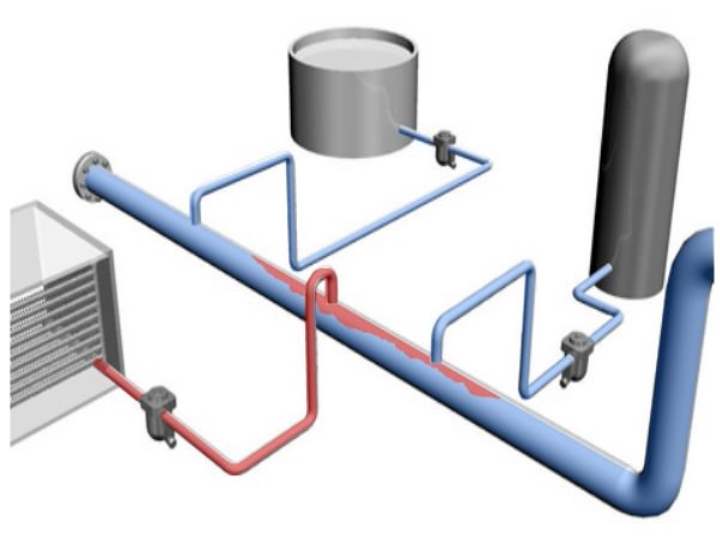

A sudden increase in pressure in the pipe occurs if, when the pump is turned on, the impeller starts to run at high speed.
In an autonomous heating system, ball valves are increasingly being installed, which do not have a smooth running. Rapid movement of the crane has a negative property, because it causes water hammer.
The use of screw cranes is considered safer, because the device provides smooth unwinding of the axlebox.
Water hammer occurs when the system is started with unreleased air. Water entering the pipe runs into an air lock, which gives the flow back cushioning.
Elimination of the problem.
The installation of protection of pipeline systems can eliminate the causes of water hammer.
For this, various methods are used.
1. Phased shutdown of the pipeline system.
Smooth start-up or shutdown of the system guarantees the absence of water hammer, this requirement is specified in Gost.
Since the walls of the pipes are elastic, the impact energy does not affect all the power at once.Pipes compensate for a part of the impact due to the deformation of the structure, therefore, the increase in the impact force occurs gradually.
Therefore, if the total impact force is the same, then its impact will constantly decrease. Smooth or staged switching guarantees a gradual build-up of pressure, which will cause minor damage to the pipes.
Attention! It is better to install shut-off valves with a long period of time to shut off or supply water.
2. Installation of automatic structures.
The automatic control must have a setting for a smooth change in the pressure in the pipeline. For this, pumps are installed that have the function of automatically changing the number of revolutions, or equipment operating using electronic control, inside which there are frequency converters.
Attention! Automatic devices allow you to control the flow of fluid and its pressure in the system.
Automatic pumps with speed control smoothly increase or decrease the water pressure. Automation is aimed at performing two tasks: monitoring pressure drops and adjusting it if necessary.
Possible consequences of a water hammer and its danger
The signs of the phenomenon can be recognized by extraneous sounds in the system: clicks, knocks, collapses. Visual signs will also help: leaking taps, mixers, compression fittings-connectors with rubber gaskets.
When the water supply system is exposed to frequent water hammer, even with a weak force, the gaskets, seals are squeezed out first. Violation of the tightness of the system can lead to the appearance of centers of deformation and rupture of pipes.
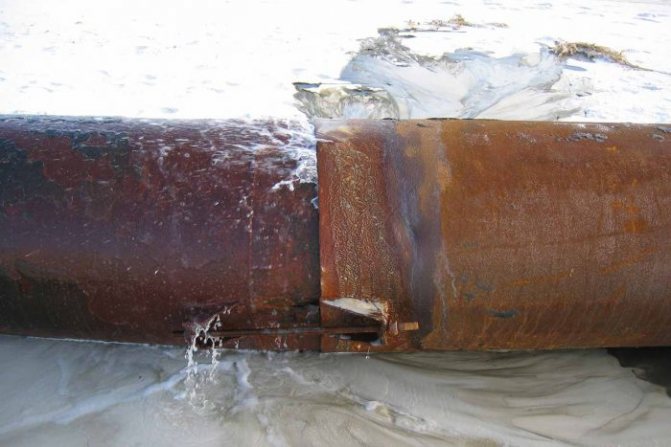

As a result of the pressure increase, the water supply is interrupted. But this is not the only nuisance. If a water hammer has led to a complete rupture of a pipe, for example, in an apartment building, the entire structure is left without water. The flow of liquid spoils the property of the apartment owners, the neighbors of the lower floors are flooded. As a result - work on the repair and restoration of several housing objects.
A water hammer in the hot water supply system, in addition to the final damage to property, threatens with burns. The danger threatens when the heating system is depressurized, where the carrier maintains a temperature of + 70C and is constantly under pressure. A break in a battery or pipeline during the winter heating season will damage the system. Frost will finish the destructive business - the pipeline will have to be changed.
Causes of water hammer
The most important reason is the abrupt closure of the shut-off valves. If the water flows in a thin stream, the risk is minimal, but with sudden openings / closings of the tap, the danger is maximized.


Why else does a water hammer occur in the water supply system:
- With sudden switching on of powerful pumps. It occurs when the power supply of objects equipped with powerful pumping stations is unstable.
- In the presence of air plugs in the water supply system, heating. Therefore, before putting into operation closed systems with a liquid carrier, it is necessary to first evacuate the air.
Today, water hammers are considered the most common factors in the failure of water supply systems. This is due to the emergence of a new shut-off valve that does not require long turns of the valve (tap) to open / close the water.
How to protect yourself from water hammer
There are several ways to help get rid of such a phenomenon as water hammer in the water supply system. Some experts believe that a holistic approach to using multiple methods will help avoid big trouble.
- Smooth closing of valves. Such a stop of the liquid is associated with a smooth increase in pressure. In this case, a backward wave is not formed, which increases the density of the water in a countercurrent flow.
- The larger the pipe diameter, the lower the risk of water hammer formation. Because the speed of movement in a large section is always less than in a small one.
- You can use elastic inserts in front of the shut-off valves, which will expand with increasing pressure, partially extinguishing it.
- Installation of expansion joints. For example, this role can be played by a hydraulic accumulator, its capacity (volume) is sufficient to accept excess water ejected from the pipeline by high pressure. You can install a so-called pressure switch in the water supply system. It does not save from water hammer, but it turns off the pump if the pressure in the network begins to exceed a certain level. Please note that the relay does not immediately turn off the pumping unit.
- One of the most effective ways to get rid of water hammer is to install a special valve. A rigid diaphragm is installed inside it, which, with increasing pressure in the water supply network, begins to expand, that is, increases the volume of space for the expanding liquid. This protective element is usually installed next to the pump after the check valve.

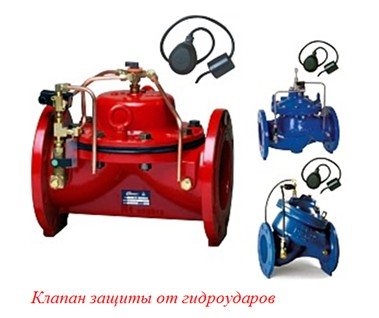
Water hammer protection valve - Today manufacturers also offer completely unique installations against water hammer. For example, the Ermangizer system. It is based on a system converter that starts the pump smoothly. In this case, the system fully controls the operation of the pump. With its help, you can guarantee a stable uniform flow of water from a tap or mixer.
There is one more point that concerns the purely legal side of the issue. All engineering communications of an apartment building belong to the management companies that serve them and are responsible for them. So, while operating these networks, it is necessary to assess the water supply system and the rest as well. The thing is that there are too many consumers in such houses, each of which must be supplied with water under a certain pressure. And this is indicated in the legislative documents.
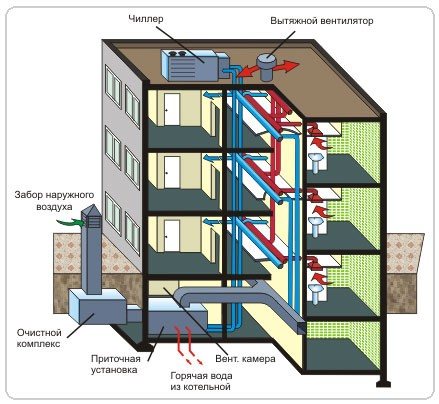

Water supply stand of a multi-storey building
That is, it turns out that on the last floor of, say, a twenty-story building, the water from the tap should flow in the same way as in the apartment on the first floor. Therefore, inside the water supply system, excess pressure is created by pumps in order to balance its indicators along the height of the riser. Now imagine what would happen if a large number of consumers were switched off at once, which usually happens at night. The pressure in the riser will quickly rise, which leads to hydraulic shocks. Therefore, it is the management companies who are responsible for the installation of expansion joints or other devices that contain water hammer.
Hence the conclusion that if the company did not check the water supply at home, if the protection systems work poorly or do not work at all, then the head of this company is responsible for everything. To him all the complaints and claims. And if the management only unsubscribes, then you can safely go to court, which will take the side of consumers, that is, the residents of the house.
Introduction of shock absorbers
Hydroaccumulators and dampers implemented today are capable of simultaneously performing several important functions. They not only collect liquid, but also eliminate excess water from the system, and also help prevent various undesirable manifestations. Hydraulic accumulators perform all the functions of compensating units. They are installed only in the direction of the main flow of water in those sections of the heating circuit, where the probability of a sudden decrease or increase in the level of the measured pressure is especially high.
A kind of extinguisher, as well as a hydraulic accumulator, in practice, is a capacious flask made of steel, which can easily fit up to 35 liters of liquid. They include two sections separated by a durable rubber or rubber partition at once.In the event of an increase in pressure, all water hammer is redirected to the reservoir. Due to the bending of the involved membrane at the moment of a sharp increase in the indicators, specialists manage to achieve the effect of forced expansion of the contour.
Pipes made of heat-resistant reinforced rubber or elastic plastic act as shock-absorbing elements. To achieve the desired effect, it is quite enough to use a product with a length of 35 centimeters. If the pipeline is long, then the section of the shock absorber must be increased by at least 12 cm.
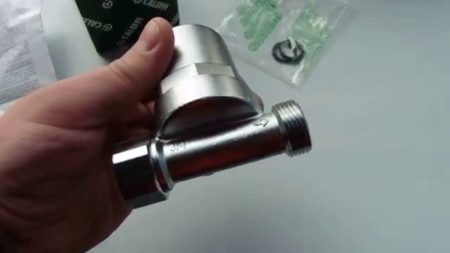

High-quality water hammer damper
Options for improving the entire system as a whole
Improvement of the entire system implies the installation of devices for the complete elimination of overpressure.
Water hammer damper and accumulators
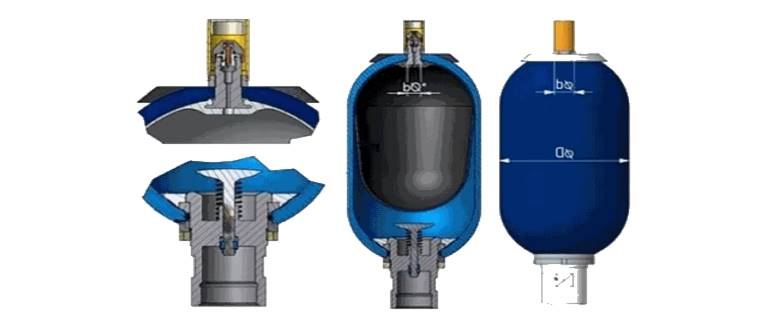

The work of these elements includes the following actions: collecting water with the subsequent removal of its excess from the system and preventing water hammer.
The accumulator is mounted in the most likely place of pressure drops along the movement of water in the system. Outwardly, these devices represent steel flasks with a volume of up to 30 liters. Inside, the structure is divided into two parts by means of a rubber or rubber membrane. During pressure fluctuations, water shocks are "directed" to the tank, where they are compensated due to the flexible membrane. Pipes made of elastic plastic or reinforced rubber are also used for shock absorption. Moreover, it is enough to use a section of such a shock-absorbing pipe with a length of only about 0.2-0.3 meters. In the case where the system is more extended, you can add another 0.1 m of the shock absorber.
Diaphragm valve


Installation of this element is carried out near the pump at the pipe bend. With an increase in pressure, it removes an excess of fluid. The valve can be driven in one of two ways:
- Using the controller
- Using a pilot device. At the moment of the occurrence of increased pressure, the element is completely opened. And during the period of normalization, it gradually closes.
Thermoregulation valve shunt
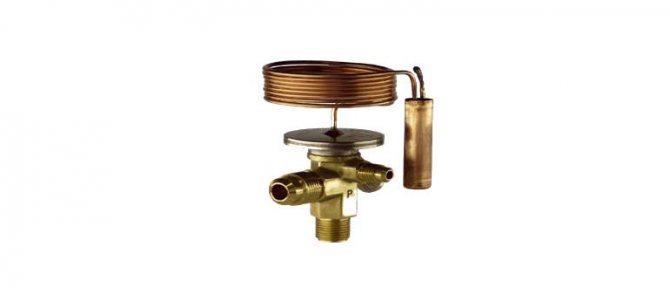

The design of the device is represented by a tube with a diameter of 0.2 - 0.5 mm. The shunt is mounted in the direction of fluid flow in the pipeline. Most often, the shunt is installed in a completely new pipeline, as various deposits on the inner surface of long-used pipes can nullify its operation. When installing it in an old pipeline, it is imperative to use water filters.
Super protection thermostat
This mechanism turns off the system when the pressure reaches the maximum allowable mark. The element design contains a spring mechanism that will not allow the valve to close in the event of a water hammer.
What is water hammer in a water supply system
A water hammer is a short-term powerful increase in the pressure of a liquid that circulates in pipes. The pressure increases due to the change in the flow rate.


The pressure change sign affects the type of water hammer:
- positive - at which the pressure rises due to the sharp closing of the valve or the inclusion of the pump unit;
- negative - at which the pressure increases due to the stopping of the pump.
According to the laws of physics, even when the tap is suddenly closed, the water continues to move. Only the flow closest to the valve stops, the remaining layers continue to flow. The collision of the stopped and moving layers also causes an increase in pressure. If we imagine that the entrance was abruptly closed in front of a moving crowd, then the first rows have already stopped - the next ones stumble upon them, continuing to walk, it turns out to be a crush. Water also acts, which causes a water hammer.
The pressure rises instantly, the level rises by several tens of atmospheres. The consequences cannot be avoided.
Water hammer theory
The occurrence of the phenomenon is possible only due to the lack of compensation for pressure drops. A jump in one place causes the force to propagate along the entire length of the pipeline. If there is a weak point in the system, the material can be deformed or destroyed completely, a hole is formed in the system.
The effect was first discovered at the end of the 19th century by the Russian scientist N.E. Zhukovsky. He also derived a formula by which to calculate the period of time required to close the tap in order to avoid unpleasant consequences. The formula looks like this: Dp = p (u0-u1), where:
- Dp is the pressure increase in N / m2;
- p is the density of the liquid in kg / m3;
- u0, u1 - average indicators of water velocity in the pipeline before and after closing the taps.
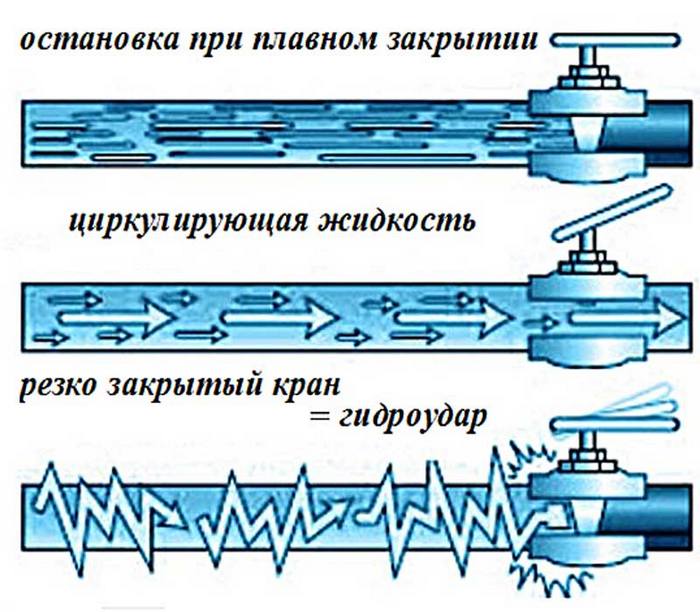

To know how to prove water hammer in a water supply system, you need to know the diameter and material of the pipe, as well as the degree of compressibility of the water. All calculations are carried out after establishing the water density parameter. It differs in the amount of dissolved salts. Determination of the speed of propagation of a water hammer is made according to the formula c = 2L / T, where:
- c - designation of the shock wave velocity;
- L is the length of the pipeline;
- T is time.
The simplicity of the formula allows you to quickly identify the speed of propagation of a shock, which, in fact, is a wave with oscillations of a given frequency. And now how to find out the fluctuations per unit of time.
For this, the formula M = 2L / a is useful, where:
- M is the duration of the oscillation cycle;
- L is the length of the pipeline;
- a - wave speed in m / s.
To simplify all calculations, knowledge of the shock wave velocity at impact for pipes made of the most popular materials will allow:
- steel = 900-1300 m / s;
- cast iron = 1000-1200 m / s;
- plastic = 300-500 m / s.
Now you need to substitute the values in the formula and calculate the frequency of oscillations of the water hammer in the section of the water supply of a given length. The theory of water hammer will help to quickly prove the occurrence of the phenomenon and prevent possible risks when planning the construction of a house or replacing the plumbing, heating system.
A few words about the theory
On the occurrence of shock phenomena in pressure pipelines when the shut-off valves were closed, it became known with the beginning of their operation.
Initially used, cork valves instantly cut off the flow of water, initiating a water hammer.
And what do you know about such a phenomenon as cavitation, what it is, is written in a useful article. Read how you can make a do-it-yourself cavitation heat generator.
How to descale the washing machine is written here.
On the page: https://ru-canalizator.com/kanalizatsiya/vygrebnaya-yama/zhiroulovitel.html it is written about the sewerage grease trap device.
Destruction of centralized water supply pipes, as a result of this, the phenomenon took place, practically, in every city.
To varying degrees, work on the study of water hammer was carried out both in Russia and abroad, in particular:
- by the Montgolfier brothers,
- Swiss inventor E. Argan,
- M. Bulton,
- Professor of Kazan University I.S. Gromeka.
Mass destruction of water pipes in Moscow at the end of the 19th century, the City Administration, which was operating at that time, forced to organize a commission to clarify the causes and develop methods of combating this phenomenon.
At the invitation of the Chief Engineer of the Moscow water supply system N.P. Zimin, Professor of Mechanics of the Moscow Higher Technical School Nikolai Yegorovich Zhukovsky took part in its work.
The research was carried out on the basis of the Alekseevskaya water pumping station.
Manometers and recorders were used for the work.installed on sites by cutting into a cast-iron water pipe (read how to do it here).
Sections of pipelines with a diameter of 2, 4 and 6 inches were routed over the surface and connected to a water conduit that was responsible for supplying the city.
The subject of the research was the dynamics of fluid movement, changes in pressure in pipes when the dampers are triggered.
The results confirmed that the cause of the destruction of the plumbing was there was a shock wave that appears and propagates when the shut-off valves are quickly triggered.
Based on the conclusions of the commission, measures were taken, the main one of which was the gradual closing and opening of the valves.
The collected material allowed N.E. Zhukovsky to obtain a ratio for the valve actuation time, which completely excluded water hammer, or reduced its consequences to the minimum:
- t = L * v / 75P.
The formula includes the quantities:
- t is the gate valve response time in seconds;
- L is the length of the pipeline section in fathoms;
- v is the speed of the fluid flow in the pipeline in feet, per second;
P is the allowable pressure for the pipe material in atmospheres.
This ratio and other research results were included in the work of N.E. Zhukovsky "On hydraulic shock in water pipes", the materials of which were presented in a report at the Polytechnic Society on September 26, 1897.
Basic methods of protection
To protect materials, equipment and communications from water hammer, the following methods are used:
- Installation of thermostats with built-in shunt;
- Plastic inserts;
- Installation of membrane devices;
- Control of pump operation modes according to the data of the pressure sensor in the system;
- General preventive measures.
Thermoregulators with a built-in shunt are installed as shut-off valves. A shunt is a small-diameter tube that allows excess coolant to pass through when the pressure rises.
Steel elements are most often susceptible to destruction from water hammer due to the rigidity of the structure, the absence of a shock-absorbing effect. To create a shock absorber, small sections of polymer pipes are often cut in, which have good flexibility. In the event of a water hammer, they compensate for the shock force by bending, without being damaged.
Hydraulic accumulators and expansion tanks also do a good job of increasing pressure, taking on the excess. The membrane, made of rubber or polymer, bends, compresses the air in the air chamber. Water from heating enters the vacant space, the total pressure in the system decreases.
Circulation pumps are equipped with a pressure control system. The sensor monitors the water pressure in the network. When the value is increased, it issues a command to decrease the pump speed. This system is applicable for pumps with frequency control of the impeller rotation speed.
General preventive measures to prevent water hammer and their consequences:
- Perform smooth control of shut-off valves;
- Switch on the pumps at low speed;
- Check the performance of air vents and safety valves;
- Timely, regularly bleed air from the equipment;
- Regularly carry out a visual inspection for the integrity of the structural elements of the heating;
- Monitor the integrity of the expansomate membrane.
Water hammer is a frequent and dangerous phenomenon in heating networks. Their timely prevention will save heating communications and equipment from damage, preserve their integrity and performance.
Owners of private apartments and houses often hear sharp, distinct blows in the equipped heating pipeline. Many do not pay due attention to this phenomenon, but the outcome of the situation can be very different. Specialists often have to correct the results of the destruction of important parts.
In some cases, injury to residents is possible. Water hammer in the equipped heating system is the main cause of most breakdowns and destruction of heating equipment.A high-quality and timely solution of this issue is of great importance for the stable and trouble-free operation of the system.
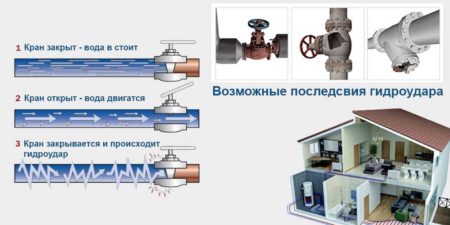

Classic consequences of an emergency
How to deal with water hammer
To protect against the effects of water hammer on water and heat supply systems, a number of measures are used. Some of them are indicative for use everywhere, while others are used for pipelines of a certain purpose.
Smooth overlap
You need to get rid of the temptation to quickly cope with such a simple task as opening or closing a valve. This should be done slowly and smoothly. If the valve is tight, then it is allowed to move its handle with small jerks. So it is customary in industrial enterprises, but indicative of execution and in everyday life.
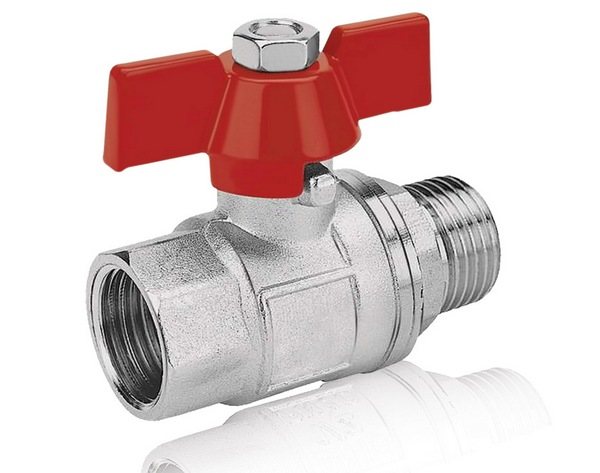

To avoid water hammer, it is recommended to close the ball valve smoothly
In this case, a water hammer still occurs. But it breaks down into several small ones in strength. The energy that acts on the pipes once when the valve is suddenly closed is broken up into portions that do not create strong pressure drops. And therefore - not dangerous.
Depreciation
With manual control of the movement of fluid flows, it is possible to realize their smooth overlap or opening. But thermostats, which control the process of operation of the heating system automatically, are not capable of this.
To mitigate water hammer in the system, shock-absorbing devices are installed in it. Before the thermostat valve installation site, a part of the rigid pipe is replaced with an elastic one. Either heat-resistant rubber or reinforced plastic are used as materials for this.
Since these materials can stretch, they will take on its force at the time of the water hammer. Having briefly increased in diameter, the shock absorber will act as a damper and release the pressure in front of the closed valve.
For most systems, it is sufficient to install a section of elastic pipe of the order of 20 - 30 cm. For extended pipes, it can be increased by another 10 cm.
Bypass surgery
The method involves manual revision of thermal valves. To implement it, knowledge of their design is required, otherwise the device can only be harmed.
The shunt is a thin tube with a diameter of 0.2 - 0.4 mm. It is inserted into the valve in the direction of fluid flow. During operation, it does not affect the performance of the system in any way, but with a sharp increase in pressure, it will help to bleed it into the pipeline behind the valve.
Note: Such measures will only help in systems consisting of new pipelines, and preferably not of metal. The presence of rust negates all efforts and tricks, as it will quickly clog the hole.
Instead of installing the tube, it may be sufficient to drill a hole of the appropriate diameter.
Protected thermostats
The industry produces thermostats equipped with a water hammer protection device. They have a spring mechanism installed between the valve and the thermal head. The availability of this device when purchasing a thermostat can be found in its technical documentation.
When the pressure is exceeded, the spring, stretching, prevents the valve from closing completely. The same process takes place as for bypassing - excess pressure is released into the pipeline downstream of the valve. When the water hammer stops, the spring will fully close the valve.
Important: Thermostats equipped with a water hammer protection system are installed in the system in exactly one direction, indicated by the arrow on the body.
Compensators
One of the compensating devices used in heating systems (it is also suitable for water supply) to protect against water hammer is a hydraulic accumulator. It is a reservoir divided into two parts by a flexible rubber or rubber membrane.
There is water in the lower part of the tank connected to the system. The top contains pressurized air.A product of a similar design is part of an automatic pumping station and serves there to turn off the pump when the nominal pressure in the system is reached.
As part of the heating system, the compensator is connected to the places of possible occurrence of water hammer. At the moment of its increasing fluid pressure presses on the accumulator membrane. The air above it is compressed, the membrane shifts towards it. Due to the increase in the volume occupied by the liquid, the pressure in it drops.
As soon as the impact of the water hammer ends, the membrane returns to its place. The use of accumulators along the way allows you to remove excess fluid from the system.
To create a shock-absorbing effect in water supply systems, in addition to hydroaccumulators, special dampers are used.
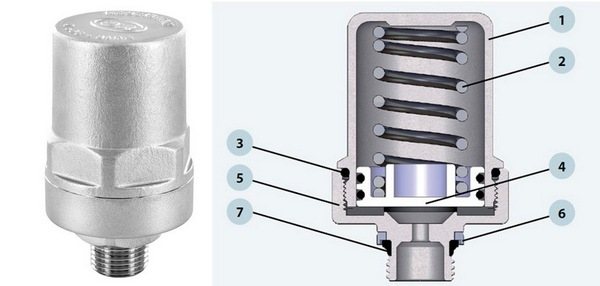

Compensator device
Safety valves
Once upon a time, doctors with high blood pressure arranged bloodletting for a patient. Less fluid means less pressure. Safety valves work in the same way.
They are placed in the most dangerous places subject to water hammer. They work either as independent devices, or from the command of the controller, which controls the operation of the system and has information about the pressure in it at specified points.
As soon as the pressure at the installation site of the safety valve exceeds the threshold level, it will open and expel excess liquid outside. Naturally, this happens where they will not cause harm or discomfort to anyone.
As the pressure decreases, the valve will close, returning to its original state.


Relief relief valve
Retrofitting of a thermostatic valve
This accessory is a compact tube. The final clearance can vary from 0.2 to 0.6 millimeters. The shunt is mounted in the direction of the circulated fluid. The main task of the part is to gradually reduce the pressure when overloads are detected. When designing autonomous systems, the shunting method is necessarily used, since only in this case it is possible to protect the new pipeline from breakage.
This effect is due to the presence of rust and other debris in worn-out pipes, which is a serious obstacle to achieving the desired result. It is for this reason that during the use of the shunt at the very outlet to the equipped heating circuit, it is advisable to install high-quality water filters.
Short description
A very common water hammer in a well-equipped high-quality heating system is a kind of phenomenon that is based on the norms of the dynamics of various substances. The manifestation itself differs in that with a periodic change in the speed of movement of the flow of the working fluid, an increase in pressure is observed. Water acts as the main heat carrier, the main indicator of which is incompressibility. During the period of circulation of the charged coolant through pipelines and heating elements, various hydraulic obstacles may arise in its path. In most cases, these are turns, sharp changes in the diameter of pipelines, as well as valves of the shut-off and control type.
In the unfavorable conditions created, the coolant can damage those elements that present a strong hydraulic resistance to the flow. These can be convectors, pipe bends, various devices, radiators and even boiler heat exchangers.
An accident may well arise as a result of gradual wear of the operating structure and its elements, or as a result of the sudden impact of a strong jump in performance. In all situations, the consequences of a water hammer entail material waste to eliminate the leak. In order not to find yourself in such a situation, one should understand the basic reasons for the formation of a water hammer.The consequences of an accident are always unpredictable, ranging from the most common breakdown of the circulation pump to large-scale flooding of the entire house. It all depends on the quality and power of the system.
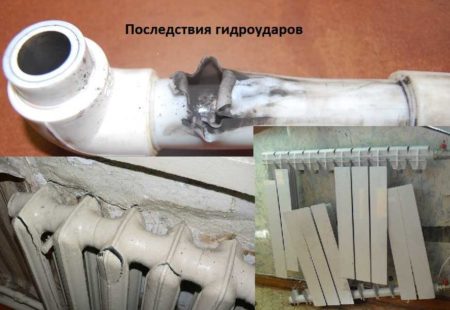

The most common consequences of water hammer exposure
Gradual system overlap
This is one of the most important requirements when starting and then shutting down a heating installation. All optimal parameters are described in detail in the basic accompanying documents. The whole reason is that the accumulated energy of the water hammer, due to the increased strength of the pipe walls, may not act with all of its power.
This feature is achieved through lightning-fast bending in the desired direction. With an equal final impact force, the power indicator of influence on a certain section of the system will significantly decrease. Thanks to smooth switching on, specialists can significantly extend the rate of pressure rise in time, minimizing the likelihood of damage to the heating system of a cottage or apartment building.
Definition
Water hammer is a physical phenomenon characterized by a rapid increase in fluid pressure in a remote area of the system and a change in the flow rate.
In heating systems, as a rule, water acts as a heat carrier, and it is known to be incompressible, like many liquids. Circulation may be obstructed. Moreover, for the appearance of a water hammer, the obstacle must appear abruptly. Because of the obstacle, the water loses speed and the gradient is reduced to zero.
During the stopping of the volume of water, the force of the pumping device continues to act on it, which produces the movement of the liquid. Due to the force of the pumping in place, the water pressure increases, which is reflected on the walls of pipes and vessels.
With the rapid removal of the obstacle, the coolant will rush towards the lowest resistance and pressure. For all that, it will acquire great speed due to the pressure difference at the high-pressure point and at the free point.
Water moves very quickly and, due to its own properties of non-compressibility, can harm the elements and structures of the heating system. The blow struck can often be compared to the force of a hammer blow with full force. Therefore, powerful water shocks in the heating system can depressurize structures, disrupt individual elements. A person runs the risk of injury and burns.
Batteries gurgle
The next reason for noise in metal heating pipes is air. If something is constantly bubbling and bubbling in the battery, like in the stomach of a sick cow - he, darling. Sound insulation of heating pipes, even if it was carried out, would not give anything - the sound will be heard through the walls of the radiator.
Are you on the top floor of a house with a bottom outlet (when both the heating supply and return pipes are located in the basement)? Then look for a Mayevsky faucet on the radiator or a jumper between adjacent rooms - a device that helps to release air.
In all other cases, it is worth looking for a counter-slope (of course, if the heating system is working normally in all other respects, except for noise). A radiator hanging with a skew or a section of supply to it, which is lower at the riser than near the battery itself - this is what you have to fix, and most likely in the summer - to stop the heating system in winter for a long time, especially in the harsh climate of Siberia or the Far East, hardly would be a good idea.
